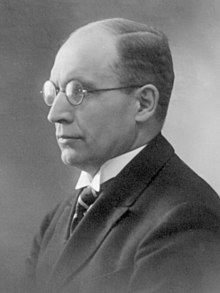Uluot's cabinet
Government of the Republic of Estonia under Prime Minister Jüri Uluots (Uluots Cabinet). Term of office: October 12, 1939 to June 21, 1940.
government
According to official counts, the Uluot government was the 27th government of the Republic of Estonia since independence was declared in 1918. It remained in office for 254 days.
On June 21, 1940, the Red Army occupied Estonia. This meant that the government was no longer able to exercise state power in Estonia. By fleeing to Sweden , Uluots was the only member of the government to escape his arrest. With the exception of himself and Education Minister Kogerman , all cabinet members died between July 1941 and September 1943. Kogerman survived the deportation to the interior of Russia and died in 1951.
cabinet
| Department | Surname | Term of office |
|---|---|---|
| Prime Minister | Jüri Uluots | October 12, 1939– June 21, 1940 |
| Foreign minister | Ants Piip | October 12, 1939– June 21, 1940 |
| Interior minister | August Juerima | October 12, 1939– June 21, 1940 |
| Minister of Justice | Albert Assor | October 12, 1939– June 21, 1940 |
| Minister of Agriculture | Artur Tupits | October 12, 1939– June 21, 1940 |
| Minister of Education | Paul Kogerman | October 12, 1939– June 21, 1940 |
| Economics Minister | Leo Sepp | October 12, 1939– June 21, 1940 |
| Minister of War | Nikolai Reek | October 12, 1939– June 21, 1940 |
| Minister of transport | Nikolai Viitak | October 12, 1939– June 21, 1940 |
| Minister of Social Affairs | Oskar Kask | October 12, 1939– June 21, 1940 |
| minister | Ants Oidermaa | October 12, 1939– June 21, 1940 |
End of the republic
In the secret additional protocol to the German-Soviet non-aggression pact ("Hitler-Stalin Pact") of August 23, 1939, National Socialist Germany and the Soviet Union divided Eastern Europe into spheres of interest. Among other things, Estonia, Latvia , Finland and later Lithuania fell to the Soviet sphere of interest.
Under threat of military force, the governments of Estonia, Latvia and Lithuania approved the stationing of Red Army troops in their countries in the autumn of 1939 after the Soviet invasion of Poland . The stationing was initially limited to certain bases . Finland, which refused to give in to pressure from Moscow , was invaded by the Soviet Union in November 1939 in the " Winter War ".
Despite the troops stationed in Estonia, Stalin did not intervene in Estonian domestic politics until mid-1940. However, on June 17, 1940, the Red Army took power across Estonia. The Estonian armed forces were disarmed, and over 100,000 Soviet soldiers were stationed across Estonia. As Stalin's envoy, his confidante Andrei Zhdanov de facto took power in the country. World politics was distracted by the German invasion of France, Belgium, the Netherlands and Luxembourg (May 10 to June 25, 1940) and paid little attention to the Baltic States .
On June 21, 1940, the Soviet occupying power staged demonstrations calling for the overthrow of Uluot's “bourgeois” government. On the same day, under pressure from Moscow , the Estonian President Konstantin Päts appointed the Estonian writer Johannes Vares as Prime Minister and a left-wing Moscow puppet government made up of intellectuals and members of the labor movement. The list of names was given by the Soviet authorities.
The new Vares government took office when President Päts was sworn in on June 22, 1940. Pats were inside the Soviet Union in July with his wife deported . On August 6, 1940, Estonia was incorporated into the Soviet Union as the Estonian SSR .
(Exile) government
Prime Minister Uluots was the only member of the government to avoid his arrest. He fled into exile in Stockholm in September 1944 . There he died of cancer in January 1945.
The Estonian constitutional lawyers do not recognize the appointment of Johannes Vares as Prime Minister on June 21, 1940, because it came about under pressure from the Soviet Army. Because President Päts was under house arrest by the Soviet authorities and was later deported, Uluots was legally responsible for representing the President from June 21, 1940.
On September 18, 1944, in the final days of the National Socialist occupation of Estonia and the withdrawal of German troops, Uluots appointed the Estonian politician Otto Tief as the Prime Minister's representative and a new government as executive president . However, on October 10, 1944, Tief was arrested by the Soviet troops advancing into the Baltic States and sentenced to ten years in a labor camp.
After Uluots' death on January 9, 1945, August Rei took over the post of "Prime Minister with the duties of President" ( Peaminister Vabariigi Presidendi ülesandeis ) as the constitutional head of state of the Republic of Estonia. Rei, who held the office of foreign minister in the Tief cabinet, had fled to Sweden as early as 1940 and lived there in exile until his death in 1963.
See also
Web links
- Cabinet List (Estonian State Chancellery)
Footnotes
- ↑ as of October 28, 1939 also deputy prime minister according to § 50 paragraph 2 of the constitution.
- ↑ http://www.estonica.org/et/Kuidas_okupeeriti_Eesti_1940_a/
- ↑ http://www.estonica.org/et/Varese_valitsus/
- ↑ § 46 of the Constitution of the Republic of Estonia from 1938 and the "Law on the Representation of the President" ( Memento of the original from March 4, 2016 in the Internet Archive ) Info: The archive link was automatically inserted and not yet checked. Please check the original and archive link according to the instructions and then remove this notice. ( Vabariigi Presidendi asetäitmise seadus , RT 1938, 36, 313)
